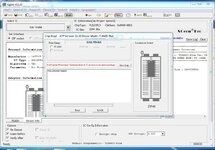@cheesestraws @unity Catching up on you guys' progress got me wondering...
So I am as sure as I can be without ordering part that I have the cable components identified correctly.
Years ago I got some DX10-28 samples from the local Hirose representative:
![IMG_1549[1].JPG IMG_1549[1].JPG](https://68kmla.org/bb/data/attachments/43/43600-4cfa24ed1c7982d03dfdbe46cf7cb975.jpg)
I just pulled an Outbound cable out of the drawer and confirmed that they mate properly:
![IMG_1548[1].JPG IMG_1548[1].JPG](https://68kmla.org/bb/data/attachments/43/43602-f02ab4c642b357bef4edb56bc0599b2a.jpg)
![IMG_1547[1].JPG IMG_1547[1].JPG](https://68kmla.org/bb/data/attachments/43/43603-27bca7b7145a6b011af1ab92b883cb36.jpg)
![IMG_1546[1].JPG IMG_1546[1].JPG](https://68kmla.org/bb/data/attachments/43/43604-e440a1d13629a0f17a0e2f0b4f03ddec.jpg)
And the datasheet says the plug for the DX10-28 is the parts I have listed, so that information should be correct....
Also snapped a couple of photos of the Citizen floppy mechanisms Outbound used. Not directly relevant to this conversation, but I've always wondered if these are stock, unmodified PC mechanisms, or if Outbound did anything unnatural to them. If we could find a PC version of this model Citizen floppy to compare with. Check for bodge wires, etc.
![IMG_1550[1].JPG IMG_1550[1].JPG](https://68kmla.org/bb/data/attachments/43/43605-bb818a8c8b708a373112f5f973c6979e.jpg)
So I am as sure as I can be without ordering part that I have the cable components identified correctly.
Years ago I got some DX10-28 samples from the local Hirose representative:
![IMG_1549[1].JPG IMG_1549[1].JPG](https://68kmla.org/bb/data/attachments/43/43600-4cfa24ed1c7982d03dfdbe46cf7cb975.jpg)
I just pulled an Outbound cable out of the drawer and confirmed that they mate properly:
![IMG_1548[1].JPG IMG_1548[1].JPG](https://68kmla.org/bb/data/attachments/43/43602-f02ab4c642b357bef4edb56bc0599b2a.jpg)
![IMG_1547[1].JPG IMG_1547[1].JPG](https://68kmla.org/bb/data/attachments/43/43603-27bca7b7145a6b011af1ab92b883cb36.jpg)
![IMG_1546[1].JPG IMG_1546[1].JPG](https://68kmla.org/bb/data/attachments/43/43604-e440a1d13629a0f17a0e2f0b4f03ddec.jpg)
And the datasheet says the plug for the DX10-28 is the parts I have listed, so that information should be correct....
Also snapped a couple of photos of the Citizen floppy mechanisms Outbound used. Not directly relevant to this conversation, but I've always wondered if these are stock, unmodified PC mechanisms, or if Outbound did anything unnatural to them. If we could find a PC version of this model Citizen floppy to compare with. Check for bodge wires, etc.
![IMG_1550[1].JPG IMG_1550[1].JPG](https://68kmla.org/bb/data/attachments/43/43605-bb818a8c8b708a373112f5f973c6979e.jpg)

![IMG_1554[1].JPG IMG_1554[1].JPG](https://68kmla.org/bb/data/attachments/43/43670-286f13351e3d0601d904e903eea3d461.jpg)

![IMG_1555[1].JPG IMG_1555[1].JPG](https://68kmla.org/bb/data/attachments/43/43689-aa82227efce139700eb0ff198519ac76.jpg)